Menu
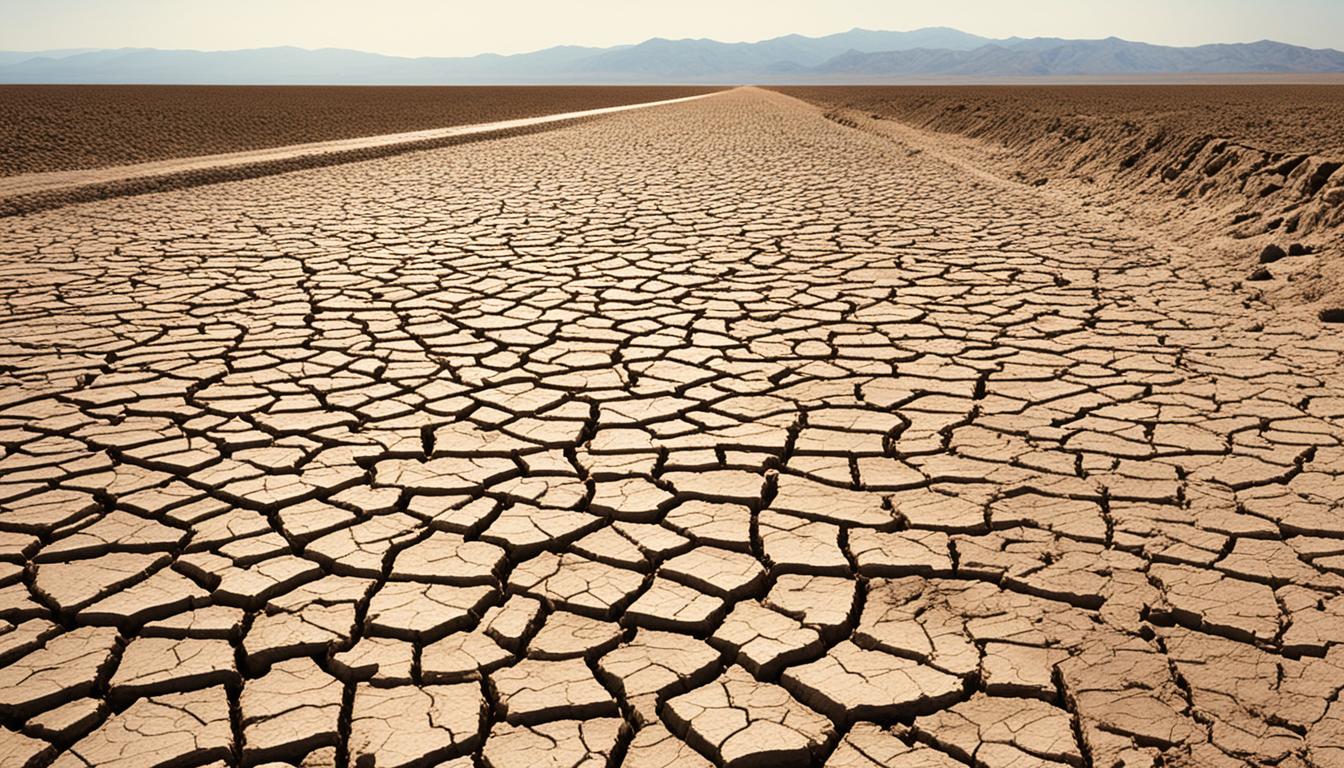
Did you know that 70% of all fresh water withdrawals come from agriculture? This massive number shows we urgently need sustainable water use for global food security. Experts, like Katherine Sentlinger, warn about water’s critical role in farming. This is especially important as the world’s population grows. With water used for home, work, and nature, we have a big water scarcity problem.
The FAO and other groups are facing these issues head-on. They’ve started projects to tackle water scarcity alongside climate challenges. Their goal is to make all farming parts, from crops to animals, more sustainable. They want to improve how water is used, like better irrigation and managing water in the rain. Doing this can help ensure our future food needs are met with less strain on water.
Facing the water scarcity challenges in agriculture is vital for agriculture sustainability. It’s crucial for a steady food supply. Agriculture uses the most water globally, about 70%. This huge demand strains our limited water sources.
Several studies have looked into the importance of water for farming. Hoekstra et al. (2012) discussed how agriculture relies heavily on water. Jabal et al. (2022) showed that climate change harms crop growth and food production impact. Harris et al. (2020) found that our eating habits play a big role in water use.
Looking at the water use of the wine industry, Saraiva et al. (2020) showed how focusing on specific sectors helps. One study on Sicilian artichokes by Lo Giudice et al. (2014) revealed ways to use water better in farming.
Every year, the world uses about 4 trillion cubic metres of water. By 2050, we might use 15% more for farming, putting more stress on water. But over 40% of this water use is not sustainable. This hurts the environment and adds to water scarcity.
Today, water scarcity affects around 4 billion people, some for a whole year. This lack of water slows down farming, which can lead to not enough food and poverty. Countries like India, China, and many in Africa and the Middle East worry about growing enough food because of water issues.
To fix this, we need to work on agriculture sustainability together. This includes using better irrigation, saving water more, and farming in ways that help the land recover. Leaders should help with better national water plans and support new ideas in farming.
Climate change is making water scarcity worse. So, we need a big plan that looks at water for everyone, uses water well, and improves how we collect and share data. This plan, IWRM, is crucial for the future.
Pedro-Monzonís et al. (2015) looked at how we measure drought for water planning. They said we need better ways to handle water scarcity worldwide.
To end, tackling water scarcity challenges in farming is urgent. Everyone, from politicians to farmers, must find ways to use water smarter. This ensures there’s enough food for all in the future.
Water scarcity is a big problem for growing food around the world. The issue of efficient water use and the fight for water between farming and other areas is very important. Global water resources are running low, and we need to act fast and smart to fix this.
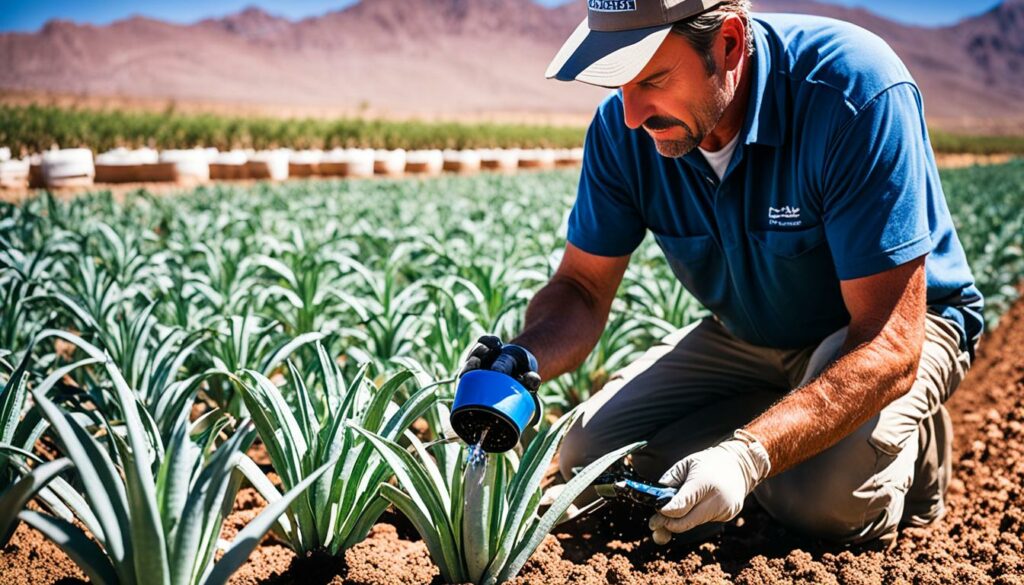
Efficient water use is key for more and better food. By using water wisely, we can save a lot of it. For example, in a place in Iran, a study showed how too many people and farming methods can harm water resources.
Using water better helps save water for the future and grows healthier food plants. This means more food can be grown.
Farming needs a lot of water, much more than most other uses. This causes fights over who gets the water. A group called the International Water Management Institute says these fights happen a lot.
We need to use water better to keep making food and to share the water more fairly.
It’s very important to find ways to use water that don’t hurt the earth. Some researchers say we should carefully look at how we use water.
Looking at how the wine industry treats its wastewater can teach us a lot. By learning from these efforts, we can use water smarter in all farming. This is important because water is becoming less available.
| Study | Key Findings |
|---|---|
| Meneses Y.E., Stratton J., Flores R.A., 2017 | Water scarcity poses significant challenges in food processing. |
| Pellegrini G., Ingrao C., Camposeo S., Tricase C., Contò F., Huisingh D., 2016 | Varying water usage levels in olive growing systems; highlighting efficient practices. |
| Layani G., Bakhshoodeh M., Zibaei M., Viaggi D., 2021 | Population growth and agricultural practices heavily impact water resources. |
| Saraiva A., Rodrigues G., Mamede H., Silvestre J., Dias I., Feliciano M., Oliveira E Silva P., Oliveira M., 2020 | Winery wastewater treatment systems can significantly reduce water footprint. |
Irrigation management is key for using water wisely and growing more crops. In the United States, irrigation systems used up 42% of the fresh water in 2015. This shows we must handle water better.
In the U.S., farms using irrigation make more than half of the crop sales. Yet, states like Nebraska need careful management. They have a lot of irrigated land but must not waste water.
Over time, we’ve gotten better. From 1969 to 2017, we reduced water use per crop significantly. This is important for growing crops while saving water.
New irrigation tech, like drip and sprinkler systems, saves water. In the western U.S., more farms used these in 2018 than before. It shows investing in new tech can really help.
It’s not just about big farms. Small-scale irrigation helps farmers in developing countries. It saves water and protects the environment. This is vital for food for everyone.
“Effective irrigation management is not just about increasing water efficiency; it’s about ensuring we can sustain and boost agricultural productivity for future generations.” – Katherine Sentlinger
It’s also crucial to look at what we’re growing. In 2017, corn needed the most water in the U.S. Efficient water use is critical to keep producing.
| Year | Total Irrigated Cropland (Million Acres) | Average Irrigation Application Rate (Acre Feet per Acre) | Pressurized Irrigation Usage in the Western U.S. |
|---|---|---|---|
| 1969 | 58 | Over 2 | 37% |
| 2017 | 58 | Under 1.5 | 72% |
We must update irrigation now more than ever. The USDA says we need to feed more people by 2050. New tech can help us grow more without harming the planet.
Upgrading irrigation systems helps boost farming. It makes crops grow better while saving water globally. The World Bank suggests using better irrigation methods to use water wisely and get more crops.
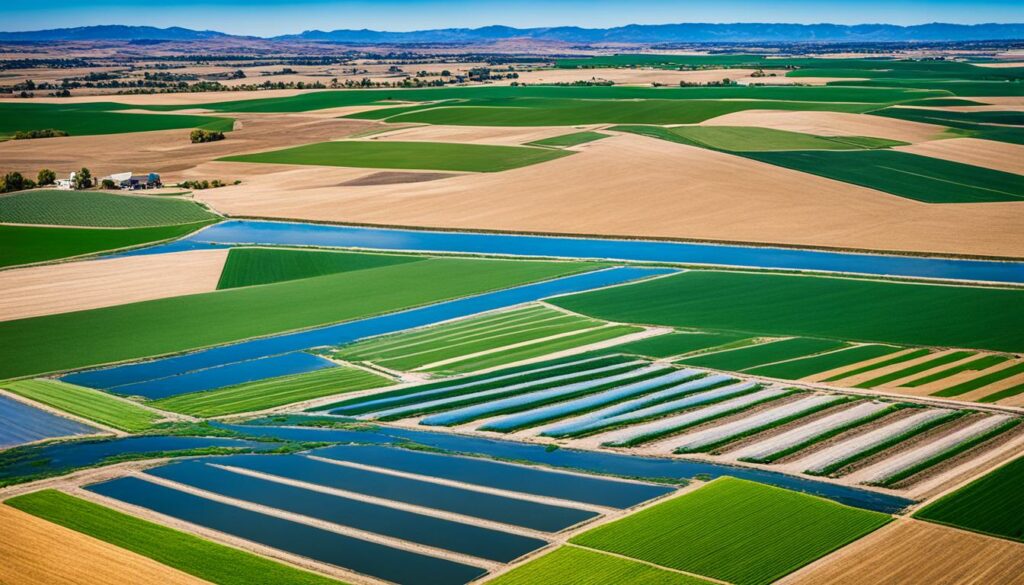
By upgrading, places with little water can save a lot. Oman aims to use 70% less water with drip irrigation. This shows how updating systems can be a big win.
In the U.S., farming uses much of the water. Using better techniques like center pivot irrigation helps. It not only saves water but also helps farming last long.
Getting more crops with less water is key worldwide. Micro-sprinkler systems spread water evenly. This stops waste and helps plants grow better.
Let’s look at how new irrigation tools help save water and grow more food:
| Irrigation System | Examples | Water Savings (%) | Productivity Boost |
|---|---|---|---|
| Drip Irrigation | Oman (2023) | 70% | Great for dry places, uses water smartly |
| Center Pivot Irrigation | USA | Varies, up to 80% | Important for big farms, saves a lot of water |
| Micro-Sprinkler Irrigation | Global | Stops water waste | Makes plants grow better with precise water use |
By 2025, over 1.8 billion people might lack water. This makes improving farming with smart irrigation urgent. Joining together to find and use the best techniques is crucial. It will help us fight water scarcity.
In recent years, the growth of rainwater harvesting has been remarkable. This method is now popular because it’s good for the planet and uses smart tech. As the world’s population rises, we need more ways to get water sustainably. Rainwater harvesting is part of the solution, using clever methods to collect water.
Rain catchment systems have become very advanced. They use filters that make the collected water clean enough to drink. These systems also work well with grey water and stormwater. This all helps reduce the use of city water and saves our natural water sources.
Weirs and sand dams help gather water in places with little rain. They are key for a steady water supply. By raising the water table and improving soil, they make water sources more constant. The Water Project shows how effective these methods can be. They are vital for creating sustainable water systems.
Rainwater harvesting’s success depends on good design, maintenance, and using water wisely. Even areas with low rainfall can collect plenty of water from big roofs. This means we can really make use of the rainwater we get.
| Advantages of Rainwater Harvesting Techniques | Description |
|---|---|
| Sustainability | Reduces reliance on municipal water and promotes efficient water use. |
| Smart Technology Integration | Enables real-time monitoring and optimises water usage. |
| Advanced Filtration Systems | Improves water quality for diverse applications. |
| Combination with Other Water Sources | Enhances sustainability through integration with grey water and stormwater. |
| System Design and Maintenance | Essential for the long-term viability and effectiveness of rainwater harvesting systems. |
In the field of water conservation agriculture, the role of drought-resistant crops is key. These plants are designed to do well in low-water settings, vital for climate-resilient farming. Many studies back up this idea. They show how these crops help keep food production strong, even when there’s not much water.
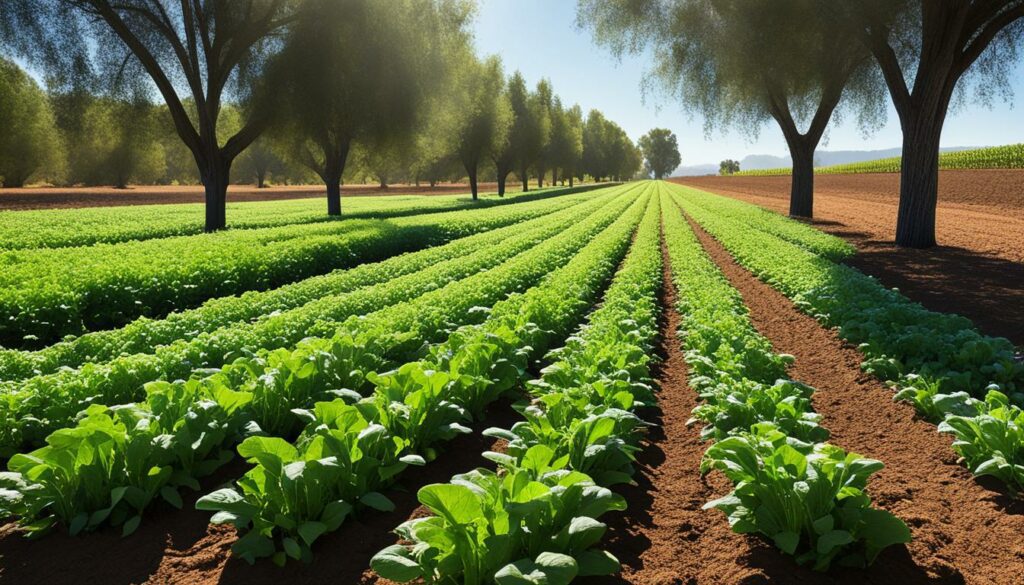
An article by Anjum et al. (2011) looks at how plants react to drought. They found some crops can still grow when water’s scarce. These drought-resistant crops are crucial for farming that saves water and for keeping our food supply steady.
Looking at the work of Levintal et al. (2023) on Ag-MAR, they focus on techniques that help recharge water underground. This helps farming areas stay healthy for longer. By combining this with using drought-resistant crops, farming becomes more ready for climate changes.
O’Connell (2017) suggests a smart way to use drought-resistant crops with careful watering. This teamwork helps agriculture face climate change challenges better.
Using drought-resistant crops is crucial for strong and lasting farming. It not only helps with water conservation agriculture but also makes food production more dependable against climate issues.
Adopting sustainable farming practices is key to keeping agriculture going with less water. Ways to improve soil health, like composting and mulching, help. They cut down on water disappearing and make sure the soil keeps water well. In the Apulia region, studying how olives need water is important for managing it well.
Knowing how much water food needs worldwide helps with lasting farming. Doing things like crop rotation and tilling the ground carefully make the soil better. This stops it from washing away and keeps the water, making farming more stable.
Reusing land for many good reasons can help farming areas and the people around them. Looking at Ag-MAR, as described by Levintal et al. (2023), helps use groundwater wisely. It not only helps now but also prepares for less water in the future.
Looking closely at how much water we use in farming and if we put enough back is crucial. The right ways to put water back into the ground can lessen harm from farming. This makes sure we use water and land in a way that keeps going for a long time.
To sum up, using sustainable farming practices, taking care of the soil health, and rethinking how we use the land are big steps. They save water, make farming areas healthier, and keep them going for our children. It’s all about making sure nature and farming work well together.
It’s crucial to manage groundwater depletion for farming needs and future water supply. Groundwater is key, giving almost half of the water for growing crops. But, too much pumping out can hurt, especially in places like California’s Central Valley.
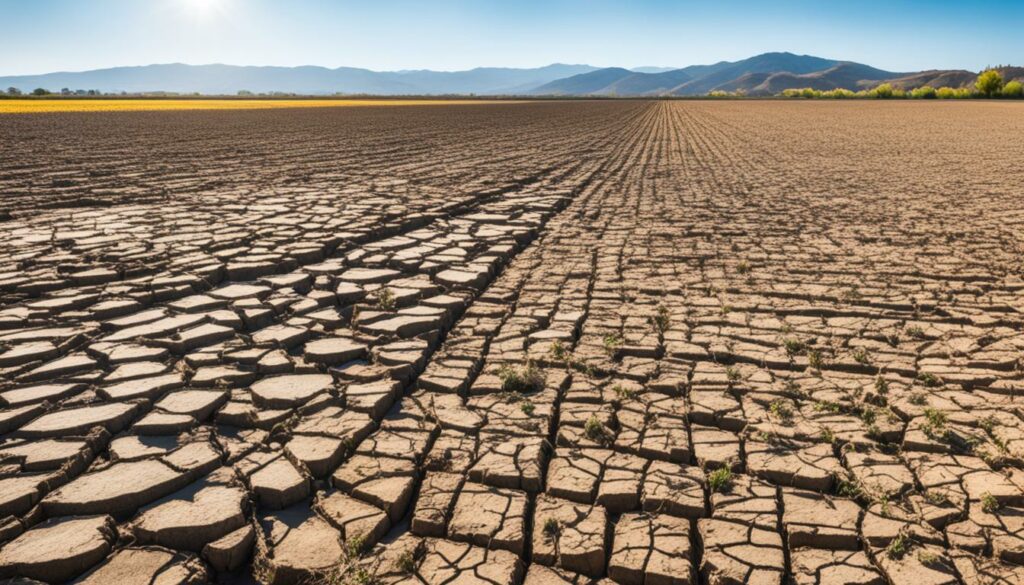
Over-pumping groundwater badly affects nature and economy. In NENA, water levels drop 1 metre each year, hurting farm output. This leaves many farms with less money.
In California, the Central Valley’s water loss grew a lot over the years, jumping from 1.86 km3/yr to 8.58 km3/yr in dry times. Using too much water causes land to sink and harms the environment. Without action, there’ll be less food and shaky finances.
Keeping an eye on how much water we’re using is important. The Groundwater Accounting Platform helps by keeping track in real time. This makes it easier to take steps to use water wisely.
Experts say good tracking and adding water back can lessen the harm of too much water use. Thanks to fancy new tools and even satellites, we’re getting better at watching our groundwater resources. This means we can do better at looking after it.
Using these special tools marks a step forward in saving our groundwater. They help us make smart choices for a healthy water future. This is important in fighting the problems of too little water in many areas.
| Region | Depletion Rate (km3/yr) | Impact |
|---|---|---|
| California’s Central Valley | 1.86 (1961-2021), 2.41 (2003-2021), 8.58 (2019-2021) | Food production, water quality, land subsidence |
| NENA Region | 1 metre/year | Agricultural productivity, economic stability |
Precision agriculture changes how we use water on farms. It uses advanced tech to help farmers use resources better. This lowers the use of harmful chemicals and cuts down on pollution, making farming more eco-friendly.
This farming method includes machines with GPS, drones, and sensors. They provide up-to-date information for better decisions. Satellite-based data helps farmers check on their crops, find problems early, and then fix them. This approach also saves a lot of water, which is good since farms use most of the water in the world.
Tools like drip and subsurface drip systems are very effective for saving water. Places like California and Australia have seen big water savings. There’s also a great improvement in how China uses water. Adding these water-saving tools to farming has led to much more crop being grown, especially in Africa.
| Technology | Water Savings | Regions of Implementation |
|---|---|---|
| Drip Irrigation | 20% – 50% | California’s Central Valley, Australia’s Vineyards |
| Micro-Sprinkler Systems | 20% – 50% | Various Global Regions |
| Subsurface Drip Irrigation | Up to 50% | Water-Scarce Areas |
Precision farming looks at soil, weather, and how plants are doing to make smart choices. This means using resources wisely and improving how farms work. It helps farms last longer, even with challenges like climate change.
The impact of climate change on farming is getting worse. In the West and Midwest alone, drought and floods lead to around $2 billion in losses each year. To combat this, it’s vital to use smart strategies. These include growing crops that can handle the weather changes and looking after the soil better.
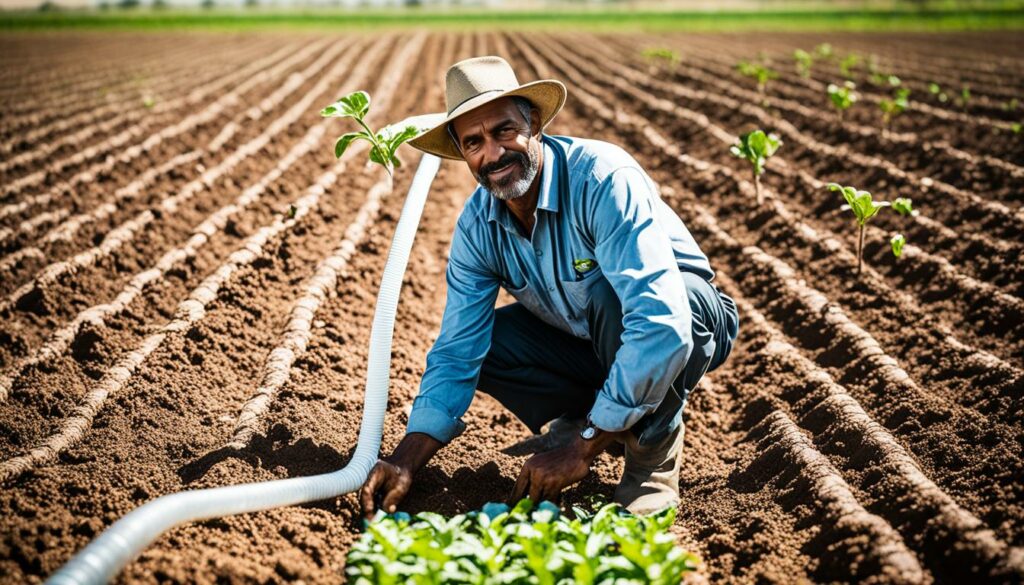
Tackling the extreme effects of weather on farming is crucial. Excess water has caused up to $10 billion in damage to the U.S. corn crop from 1989-2016. Moving to smarter farming methods is not just good; it’s necessary. These methods help address both too little and too much water. This can cut down economic losses and make farms more resilient.
Switching to crops that can handle the changing weather is key. With experts predicting big drops in snow in the Sierra Nevada by 2100, and less water in the Yakima Basin, farming must adapt. Growing a variety of crops that do well in different conditions is a smart move. This way, we can keep food coming and help farms stay afloat.
| Crop | 2020 | 2040 | 2060 | 2080 |
|---|---|---|---|---|
| Barley (bushels) | -1.9% | -0.6% | -3.5% | 1.0% |
| Corn (bushels) | -8.1% | -8.7% | -13.8% | -16.2% |
It’s clear that adapting to climate change is key for farming’s future. By using these strategies and changing the crops we grow, we can deal with water challenges. This will help keep our food supply secure and farming sustainable as our climate changes.
The global agrifood system is responsible for a third of all emissions. This makes working on climate-smart agriculture vital. We need strong policies and funding to make farming more environmentally friendly.
Because food systems use up to 70% of fresh water, managing it well is key. Smart groundwater governance means using new tech and rules to watch over water resources better.
Places like Bangladesh and Zimbabwe are setting up Climate-Smart Agriculture Investment Plans (CSAIPs). They’re getting help from the World Bank to meet the Paris Agreement’s goals. This method helps protect our water supplies and adjust farming to climate changes.
With more food needed to feed 9.7 billion by 2050, farming must become sustainable. Despite being a main cause of deforestation, only 4% of climate funds support farming. We urgently need more money for agriculture.
The World Bank now funds climate-smart farming at almost $3 billion per year. It supports projects like the $345 million in China for greener farming. And the $621 million for food resilience in Africa.
The World Bank and partners also back the $1.5 billion RCPP. This program plans to invest in eco-friendly farming and climate answers. It aims to help over 180,000 farms and save 225 million acres in five years. Notably, $100 million is set aside for projects led by indigenous groups, showing everyone’s involved and working towards a green future.
By making the RCPP agreements quicker from 15 to 6 months, green projects can start faster. This shows how good policies and money management in climate farming are making real differences. They’re leading the way to farming that’s good for the planet.
Water scarcity in agriculture needs strong collaborative water scarcity solutions. This brings together many people in farming. Around 70% of fresh water goes to agriculture. So, working together is key to making lasting changes. The FAO’s work, like the Global Framework for Action, helps different groups work together.
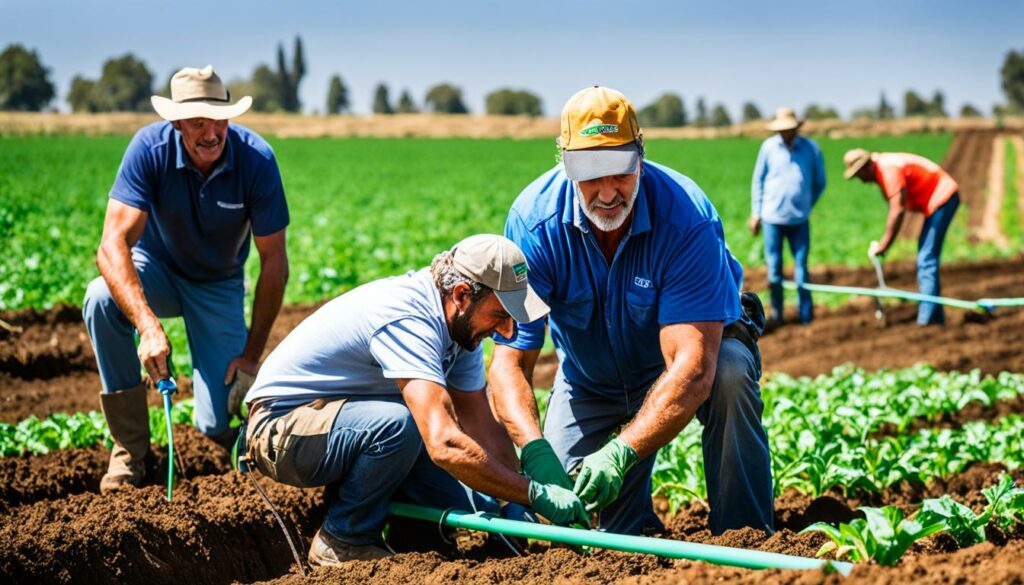
Building partnerships in farming is crucial to fight water scarcity. When we share what we know and have, we can make agriculture use water better. Things like taking care of soil and water, planting more trees, and looking after grazing lands well, help a lot. Cooperation turns small actions into strong ways to fight the effects of too little water.
Upgrading how we use water through better irrigation is also very important. Doing this helps with using water smarter and dealing with climate changes. For example, farmers with small plots can grow different things and find more ways to earn money. This makes their farms need less water and ready for different weather challenges.
Think about the big impact of droughts and floods on farming. Each year, these can cause $2 billion in losses for farmers in the West and Midwest. Too much water can be bad too, like costing the U.S. corn industry $10 billion in damages over 27 years.
| Region | Water Scarcity Challenge | Proposed Solution |
|---|---|---|
| California | 48-65% decline in Sierra Nevada snowpack by 2100 | Increased reliance on groundwater and development of resilient water management strategies |
| Pacific Northwest | Significant drops in average annual yields under severe warming scenario | Introduction of climate-resilient crop mixes |
| Southwest | Reduction in snowmelt leading to groundwater reliance | Diversification of production systems |
| Kansas | Declines in both groundwater and surface water | Adoption of sustainable water management practices |
| Midwest | Increased extreme weather disrupting crop production | Modernisation of irrigation infrastructure and enhanced soil health practices |
These big challenges need us to come together on a global scale. Working together, we can make a real difference. It’s key for securing food for everyone and making sure farmers can survive hard times.
Since 2000, over half the nation has faced droughts regularly. This has pushed the agriculture sector to adopt new water management practices. Through real-world stories, we see how smart solutions can help fight water scarcity.
Every year, agriculture uses 70 percent of the world’s fresh water. In the U.S., farming drinks up more than 80 percent of water. This number jumps to 94 percent in areas facing severe water shortages. For instance, Nebraska uses 90 percent of its water for farming. Thanks to projects like the one run by The Nature Conservancy (TNC), they saved over a billion gallons in just three years. Another effort in Central Nebraska saved 120 million gallons in the first year.
In the Colorado River Basin, farming needs 80 percent of the fresh water. TNC’s work there has made a big difference by managing water better. By working with canal companies, they’ve made water use in farming more efficient. This helps farms and the environment.
The European Union (EU) is also making big steps in managing water sustainably. They use irrigation on about 7-8% of farmland each year. This directly helps grow crops. The EU also invests in many water management projects. For example, they put €420 million towards 179 projects under Horizon 2020. They’ve also allocated €145 million for 34 water projects under Horizon Europe.
Project SUWANu Europe shares knowledge on reusing water in agriculture. It connects eight areas in the EU. Then, Project OPTAIN works on keeping water and nutrients in the soil on small farms. Project MADFORWATER gives solutions for cleaning wastewater to use for farming in Mediterranean African countries. All these projects are making a difference in fighting water scarcity in agriculture worldwide.
Tackling water scarcity in agriculture takes a detailed approach. We must manage water wisely using modern irrigation methods. Research in PLoS One in 2012 shows a key link between water shortages and how we use water to grow food.
Using drip irrigation and collecting rainwater are key to solve water scarcity. A report on the Belt and Road Initiative in 2023 outlines the importance of thinking about water use worldwide. We have to consider our water use in a strategic way.
It’s also important to farm in a way that lasts and grows crops that don’t need much water. Studies in Water and Advances in Nutrition show the value of a varied diet and choosing the right crops. We need our farming rules to follow these ways to keep our water and food supply in balance.
Working together is vital. This includes national leaders, groups that fund projects, and farmers. Every bit helps, from improving our irrigation to managing crops wisely. With these steps, we can make sure farming supports us in the future. We must act now to beat water shortages and secure our food supply for everyone.
Water scarcity in agriculture leads to fierce competition for water. It highlights the urgent need for better irrigation methods. This scarcity also affects food production and the world’s food safety.
To tackle these challenges, efficient water use and fighting groundwater depletion are key. They are vital for the future of farming.
Using water wisely boosts farm output by a lot. It helps in using water smartly and keeping it for other uses. High-tech irrigation methods are a big help in this area.
Irrigation management is crucial for using water well in farming. By upgrading the systems we use, we can do wonders. This leads to better crops and more food.
To save rainwater for dry days, we use various methods. Things like rain catchment systems, weirs, and sand dams work well. They store water for farming and help recharge the ground.
Drought-resistant crops need less water. This feature is great during dry times. They help farms keep producing food even when water is scarce.
Running out of groundwater can hit farming hard. It’s vital to track water availability. Using tools for this helps in making wise water use choices.
Precision agriculture uses the latest tech to water crops just right. With data from satellites, we can be very precise. This means less water waste and more efficient farming.
Adapting to climate change involves using new crop mixes and looking after the soil better. It’s about managing water wisely too. These strategies are key to farming sustainably.
Good policies and funding are crucial for farming that can bear climate changes. They support sustainable farming investments. This makes farming more robust against climate threats.
Working together is the best way to solve the water scarcity issue. When everyone pitches in, big changes can happen. It’s about joining forces to find solutions on a bigger scale.
Many real-life examples show how new water management helps. Practices like precision irrigation, storing rainwater, and planting drought-resistant crops are making a big difference. They are fighting water scarcity and increasing food supply.